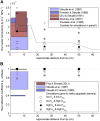Going with the Flow: Multiscale Insights into the Composite Nature of Water Transport in Roots
- PMID: 30366980
- PMCID: PMC6288756
- DOI: 10.1104/pp.18.01006
Going with the Flow: Multiscale Insights into the Composite Nature of Water Transport in Roots
Abstract
As water often limits crop production, a more complete understanding of plant water capture and transport is necessary. Here, we developed MECHA, a mathematical model that computes the flow of water across the root at the scale of walls, membranes, and plasmodesmata of individual cells, and used it to test hypotheses related to root water transport in maize (Zea mays). The model uses detailed root anatomical descriptions and a minimal set of experimental cell properties, including the conductivity of plasma membranes, cell walls, and plasmodesmata, which yield quantitative and scale-consistent estimations of water pathways and root radial hydraulic conductivity (k r). MECHA revealed that the mainstream hydraulic theories derived independently at the cell and root segment scales are compatible only if osmotic potentials within the apoplastic domains are uniform. The results suggested that the convection-diffusion of apoplastic solutes explained most of the offset between estimated k r in pressure clamp and osmotic experiments, while the contribution of water-filled intercellular spaces was limited. Furthermore, sensitivity analyses quantified the relative impact of cortex and endodermis cell conductivity of plasma membranes on root k r and suggested that only the latter contributed substantially to k r due to the composite nature of water flow across roots. The explicit root hydraulic anatomy framework brings insights into contradictory interpretations of experiments from the literature and suggests experiments to efficiently address questions pertaining to root water relations. Its scale consistency opens avenues for cross-scale communication in the world of root hydraulics.
© 2018 American Society of Plant Biologists. All Rights Reserved.
Figures






Similar articles
-
Water uptake by roots: effects of water deficit.J Exp Bot. 2000 Sep;51(350):1531-42. doi: 10.1093/jexbot/51.350.1531. J Exp Bot. 2000. PMID: 11006304
-
Chemical composition of apoplastic transport barriers in relation to radial hydraulic conductivity of corn roots (Zea mays L.).Planta. 2000 Jan;210(2):302-11. doi: 10.1007/PL00008138. Planta. 2000. PMID: 10664137
-
GRANAR, a Computational Tool to Better Understand the Functional Importance of Monocotyledon Root Anatomy.Plant Physiol. 2020 Feb;182(2):707-720. doi: 10.1104/pp.19.00617. Epub 2019 Nov 19. Plant Physiol. 2020. PMID: 31744934 Free PMC article.
-
Quantification of root water uptake and redistribution using neutron imaging: a review and future directions.Plant J. 2022 Jul;111(2):348-359. doi: 10.1111/tpj.15839. Epub 2022 Jun 15. Plant J. 2022. PMID: 35603461 Review.
-
Composite Transport Model and Water and Solute Transport across Plant Roots: An Update.Front Plant Sci. 2018 Feb 16;9:193. doi: 10.3389/fpls.2018.00193. eCollection 2018. Front Plant Sci. 2018. PMID: 29503659 Free PMC article. Review.
Cited by
-
Gradient NMR Method for Studies of Water Translational Diffusion in Plants.Membranes (Basel). 2021 Jun 29;11(7):487. doi: 10.3390/membranes11070487. Membranes (Basel). 2021. PMID: 34209873 Free PMC article. Review.
-
Cortical parenchyma wall width regulates root metabolic cost and maize performance under suboptimal water availability.J Exp Bot. 2024 Sep 27;75(18):5750-5767. doi: 10.1093/jxb/erae191. J Exp Bot. 2024. PMID: 38661441 Free PMC article.
-
Natural variation of maize root hydraulic architecture underlies highly diverse water uptake capacities.Plant Physiol. 2023 Jul 3;192(3):2404-2418. doi: 10.1093/plphys/kiad213. Plant Physiol. 2023. PMID: 37052178 Free PMC article.
-
Phenotyping and modeling of root hydraulic architecture reveal critical determinants of axial water transport.Plant Physiol. 2022 Sep 28;190(2):1289-1306. doi: 10.1093/plphys/kiac281. Plant Physiol. 2022. PMID: 35708646 Free PMC article.
-
Controlling intercellular flow through mechanosensitive plasmodesmata nanopores.Nat Commun. 2019 Aug 8;10(1):3564. doi: 10.1038/s41467-019-11201-0. Nat Commun. 2019. PMID: 31395861 Free PMC article.
References
-
- Baluška F, Šamaj J, Napier R, Volkmann D (1999) Maize calreticulin localizes preferentially to plasmodesmata in root apex. Plant J 19: 481–488 - PubMed
-
- Barberon M, Vermeer JEM, De Bellis D, Wang P, Naseer S, Andersen TG, Humbel BM, Nawrath C, Takano J, Salt DE, et al. (2016) Adaptation of root function by nutrient-induced plasticity of endodermal differentiation. Cell 164: 447–459 - PubMed
-
- Barrowclough DE, Peterson CA, Steudle E (2000) Radial hydraulic conductivity along developing onion roots. J Exp Bot 51: 547–557 - PubMed
Publication types
MeSH terms
Substances
LinkOut - more resources
Full Text Sources
Research Materials

